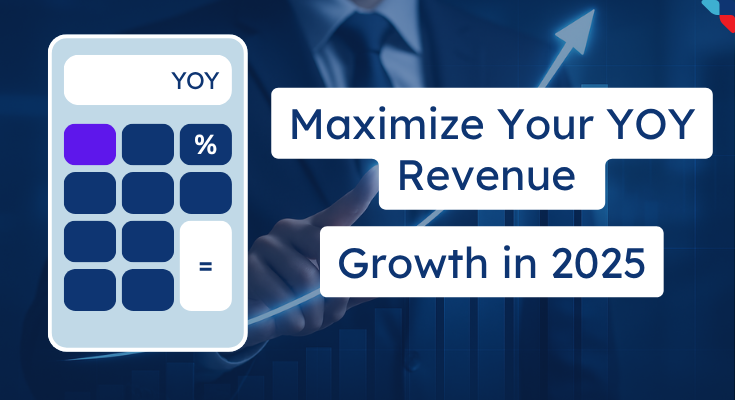This website uses cookies so that we can provide you with the best user experience possible. Cookie information is stored in your browser and performs functions such as recognising you when you return to our website and helping our team to understand which sections of the website you find most interesting and useful.
Maximize Your YOY Revenue Growth in 2025

As a business growth coach, I’ve seen firsthand how YOY revenue, or year-over-year revenue, serves as one of the clearest indicators of long-term business health. In 2025, this metric is no longer just a historical footnote on financial statements. It’s a strategic compass for investors, executives, and entrepreneurs alike. With economic uncertainty, inflationary pressures, and shifting consumer behaviors, analyzing and improving YOY growth should be at the center of every company’s roadmap. Whether you’re running a startup or leading an enterprise, understanding how to improve your YOY revenue gives you a competitive edge by revealing real growth trends, adjusting for seasonal volatility, and aligning team performance with measurable financial goals.
1. Understand the Math Behind YOY Growth
Before you can grow what you don’t understand, you need to master how to calculate YOY growth. Fortunately, the YOY growth formula is straightforward:
((Current Year Value – Last Year Value)
YOY Growth = –———————————————- x 100
(Last Year Value)
For example, if your company’s revenue in June 2024 was $10,000 and in June 2025 it was $12,000:
((12,000 – 10,000))
YOY Growth = ————————- x 100 = 20%
10,000
That’s a 20% increase in YOY revenue. This formula isn’t just a tool for financial analysts; it’s a compass for decision-makers. When leaders consistently track and benchmark year-over-year revenue growth, they develop more accurate forecasts, identify underperforming areas, and create realistic stretch goals. And don’t forget: consistency in this calculation is key. Comparing random months won’t work. Always match the same time periods year over year to ensure apples-to-apples accuracy.
2. Set Data-Driven Revenue Targets Based on YOY Revenue Trends
Many businesses set arbitrary targets based on hope rather than data. A better approach is to study your YOY revenue from the past 3–5 years and establish strategic growth trajectories. For example, if you’ve been averaging 12% YOY growth, setting a 15–18% target for 2025 may be ambitious yet realistic. On the flip side, if your company had negative YOY revenue last year, focus first on recovery strategies before scaling. Use software like HubSpot, Salesforce, or QuickBooks to run monthly and quarterly YOY growth reports. These tools allow you to visualize your year-over-year revenue trends over time and respond accordingly. The companies that win in 2025 will be the ones that turn historical data into predictive growth maps and then commit to hitting those targets relentlessly.
3. Diagnose the Drivers and Barriers of YOY Growth
Knowing your YOY revenue is great, but understanding why it’s rising or falling is where transformation begins. Break down the growth drivers: are you closing more deals, increasing average order value, improving retention, or expanding into new markets? At the same time, identify the barriers: Is customer churn eating into your year-over-year revenue? Are you facing pricing pressures or product issues? Conduct internal audits and use dashboards to track KPIs that directly impact revenue. One client I worked with was stuck at 5% YOY growth for 3 years. Once we diagnosed that 30% of customers dropped off after the first purchase, we launched a retention program and drove 22% YOY revenue growth within 12 months. Remember, you can’t fix what you don’t track.
4. Innovate Your Revenue Model for Sustainable YOY Revenue
To maintain high YOY revenue growth, you need to diversify and future-proof your revenue model. Don’t rely solely on one-time sales. Consider adding recurring revenue through subscriptions, upsells, or service packages. Look at industry benchmarks, companies like Abiomed, known for consistent medical innovation, have shown how smart product diversification can stabilize even volatile industries. While Abiomed’s annual revenue may seem far from your business size, the principles behind it, innovation, customer lifetime value, and scalable models, are universal. In 2025, digital transformation and AI-powered services are creating new opportunities for monetization. Ask yourself: What would make a customer pay monthly instead of once? What problems can you solve on a recurring basis? These answers lead directly to higher YOY revenue over time.
5. Implement Strategic Pricing to Boost Year-Over-Year Revenue
Your pricing strategy can either fuel or cripple YOY growth. If your prices haven’t changed in two years, you’re probably leaving money on the table. Start by conducting competitive pricing analysis and value-based surveys. As a business growth coach, I often advise clients to test pricing models through A/B experiments, one group sees your current prices, another sees revised ones with value-based tiers or bundles. Even a 10% price increase, if implemented properly, can significantly improve year-over-year revenue without hurting customer acquisition. Also consider strategic discounting, not blanket discounts, but seasonal or loyalty-based incentives that reward repeat buyers. The goal is to move away from “race to the bottom” pricing and toward value-driven monetization that directly supports stronger YOY revenue metrics.
6. Optimize Your Customer Retention Strategy
Retention is the unsung hero of YOY revenue. It costs 5x more to acquire a new customer than to keep an existing one, yet many businesses still focus all their energy on front-end sales. In 2025, smart companies will build retention into every touchpoint of the customer journey. That means onboarding emails, follow-up calls, personalized upsells, loyalty programs, and proactive customer service. Measure your churn rate monthly and calculate the revenue impact of each lost customer. A small reduction in churn, say, from 20% to 15%, can have a massive effect on your year-over-year revenue. I’ve seen companies go from flat YOY growth to 30% just by improving customer lifetime value with support services for small businesses and re-engagement strategies. Retention isn’t optional; it’s your YOY growth engine.
7. Leverage Automation & AI for Revenue Efficiency
Automation is no longer a luxury; it’s a necessity for increasing YOY revenue. From email workflows to sales CRM pipelines to inventory management, automating your backend operations allows your team to focus on revenue-generating tasks. But don’t stop there. In 2025, AI is a force multiplier. Use AI tools to forecast revenue trends and integrate AI into your business workflow. personalize customer communications, and even predict churn before it happens. Companies that use automation in sales and marketing see up to 53% higher year-over-year revenue growth, according to industry reports. The takeaway? Automate everything that’s repetitive and empower your team to do what only humans can: build relationships, solve problems, and close deals. The compounding effect of automation on YOY revenue is real and measurable.
8. Track, Review, and Realign Every Quarter
What gets measured gets managed, and what gets ignored slowly dies. Set quarterly revenue reviews where your leadership team analyzes YOY growth numbers, customer feedback, and KPI performance. Use these meetings to realign strategy, reallocate resources, and re-motivate your team. Include YOY revenue charts in every internal presentation so your team sees progress in real-time. Align marketing, sales, and product departments with strategic marketing services. One of the biggest killers of growth is siloed teams chasing uncoordinated metrics. In contrast, companies that align cross-functional teams around year-over-year revenue targets are 2.5x more likely to hit their goals. Treat your review process like a revenue lab, experiment, analyze, optimize, repeat.
Conclusion: Make 2025 the Year of Strategic YOY Growth
If you want to thrive in 2025, you must make YOY revenue your North Star. From understanding the formula to transforming pricing, retention, automation, and strategic planning, each element contributes to long-term, scalable year-over-year revenue success. Remember: it’s not about chasing spikes, it’s about building a consistent, upward trajectory. Use your past data as a springboard, not a crutch. Think like a strategist, act like a coach, and execute like a CEO. Whether you’re a startup founder, marketing leader, or CFO, YOY revenue is the metric that defines whether your efforts are working. Commit to these strategies now, and next year’s review won’t just show growth, it will show mastery.
FAQs
How can I increase my YOY Revenue?
To increase YOY revenue, focus on improving customer retention, refining pricing, expanding high-margin products, and leveraging data analytics for better decision-making.
What is a good YOY growth rate?
A “good” YOY growth rate varies by industry, but most healthy businesses aim for 10–25% annually. High-growth startups might target 50% or more.
How does Abiomed achieve strong annual revenue growth?
Abiomed’s annual revenue surged through innovation, niche market leadership, and consistent investment in R&D, resulting in strong year-over-year revenue growth.
Can small businesses track YOY revenue effectively?
Yes. Even simple tools like Excel or QuickBooks can help track YOY revenue. Small businesses should start early to measure growth trends and pivot accordingly.

Let's Start Your Project
Get free consultation for your digital product idea to turn it into reality!
Get Started





